Antelope Island in the Great Salt Lake Part-2
May 30, 2007.
We did not arrive in Layton, UT until after noon.
As you will recall we were in Salt Lake City earlier in the day touring Temple
Square.
After touring the Temple
Square area in Salt Lake City we returned to the motorhome and headed
south to a Super Wal Mart located in Layton, Utah at exit 334, where we dropped
the motorhome and headed to Antelope Island in our Saturn.
When we returned
we moved the motorhome to a strip mall parking area adjacent to Wal Mart because
there was more space available for overnighting RV's.

We visited Antelope Island, a Utah State Park located
in the Great Salt Lake. The Great Salt Lake, as you may know, is the largest natural
lake west of the Mississippi River. The lake is a remnant of pre-historic Lake
Bonneville, which covered more than 20,000 square miles during the Ice Age. Four
distinct shorelines from the lake may be seen from Antelope
Island and include, Bonneville, Provo,
Stansbury, and Gilbert.
Currently Great Salt Lake is 75 miles long by 28
miles wide covering 1,700 square miles. At this level, maximum depth is about
33 feet. Size and depth vary greatly with seasonal evaporation and precipitation.
Water
flows into the lake from four river drainages, carrying 2.2 million tons of minerals
into the lake each year. Great Salt Lake has no outlet; water leaves only through
evaporation. Because of this, high concentrations of minerals are left behind.
Salinity level ranges between four and 28% compared to the ocean at 3%.
Salinity
is too high to support fish and most other aquatic species. However, brine shrimp,
brine flies, and several types of algae thrive in the lake. Brine shrimp and brine
flies tolerate the high salt content and feed on algae. Brine flies and brine
shrimp are primary food sources for millions of migrating birds.
Nearly
80% of Utah's wetlands surround Great Salt Lake, making its ecosystem one of the
most important resources in North America for migratory and nesting birds. The
area hosts 250 bird species each year, which represents a significant part of
the six to nine million migratory birds passing through the Pacific Flyway.
The
lake and its marshes provide resting, nesting, and staging areas for these birds.
Oolitic
sand is a unique feature of Great Salt Lake. These round grains of sand are formed
when mineral grains or brine shrimp fecal pellets are coated by concentric layers
of aragonite, a form of calcium carbonate. This is similar to how pearls are formed.
I did not have time to find and closely examine this unique form of sand. This
will have to wait until our next visit.
With that as background it is time
for us to head across the causeway connecting Antelope
Island with the mainland.
View from causeway to Antelope
Island in the Great Salt Lake
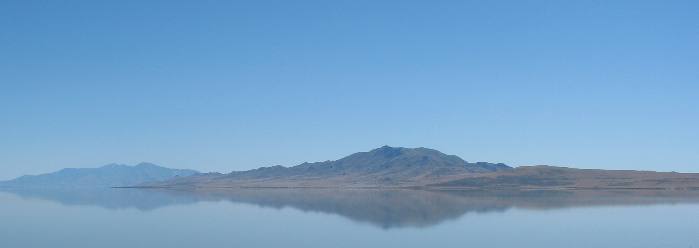
Access
to Antelope Island State Park is
from SR-108 (exit 335 on I-15) via a very long causeway. There is a State Park
fee to get on the causeway leading to Antelope
Island.
Joyce
took this picture from the causeway looking south at the south end of Antelope
Island with mountains around Provo
in the background.
View from causway to Antelope
Island in the Great Salt Lake
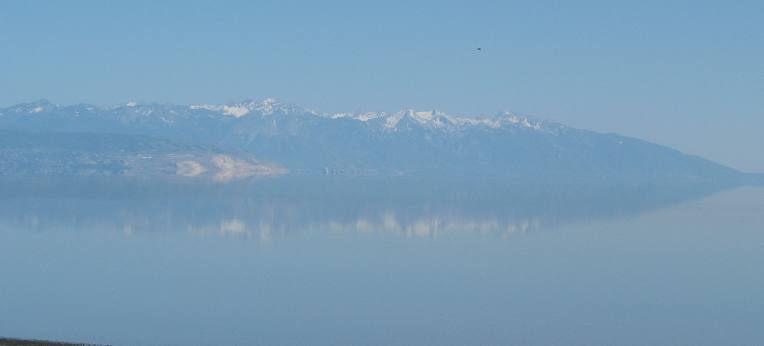
This
was taken from the causeway looking to the southeast toward Salt Lake City. The
water is part of the Great Salt Lake. The Wasatch
Mountains are in the background.
Chukar
on Antelope Island in the Great Salt Lake
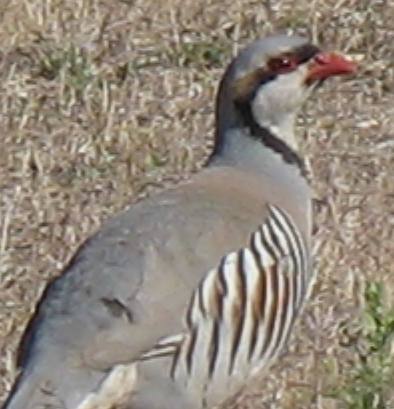
Chukar are exotic birds
that have been introduced to the area as game birds. They are thriving throughout
Utah and especially on Antelope Island.
Chukar on Antelope
Island in the Great Salt Lake
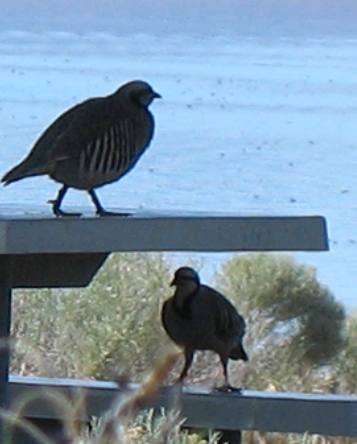
Once on Antelope
Island we immediately spotted these chukar hiding in the shade provided
by picnic tables.
Causeway to & from Antelope
Island in the Great Salt Lake
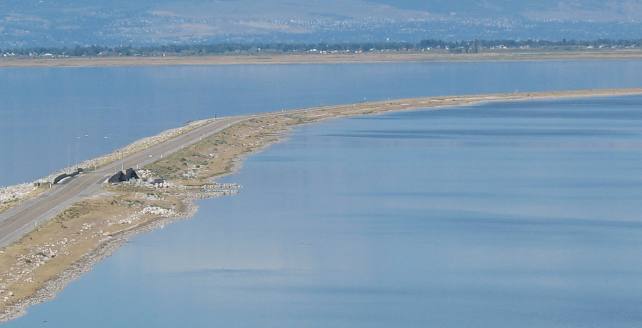
This picture is looking east from the visitor center
on Antelope Island. We have just
completed the drive from the mainland across this causeway. The water is the Great
Salt Lake. It is only inches deep in this area.
Antelope
Island is the largest of Great Salt Lake's ten islands. Protected by the
lake, the island's relative isolation has helped preserve its unique environment,
which appears today much as it did when Mormon pioneers first arrived in the Salt
Lake Valley.
The Great Salt Lake is one of the most important avian breeding
and migratory staging areas in the United States. Officially designated as a Hemispheric
Shorebird Reserve, the lake is an important stopover for long-distance migratory
birds and a home for many other species. The lake's waters and shores provide
plentiful brine shrimp and brine flies, two important sources of food. In addition,
more than 400,000 acres of contiguous wetlands around its shores provide prime
nesting habitat, food, and cover for many species.
Great Salt Lake supports
over 160,000 California gulls, more than anywhere else in the world.
Over
600,000 Wilson's phalaropes have been counted in a single day at the lake representing
more than half the total U.S. population of these birds.
Over 250,000 American
avocets nest on Great Salt Lake. This is more than the rest of the western United
States combined.
Over 1/2 million eared grebes, more than 30% of North America's
population, mass on the lake during fall migration. We saw thousands of eared
grebes feeding in the shallow water north of the causeway as we made our way to
the Island. They are shy birds and stayed out of camera range so seeing them and
getting a decent picture of one is a different matter.
Great Salt Lake is
considered the single most important nesting area for white-faced ibis in the
United States. We did not see the first white faced ibis while in the Great Salt
Lake area but we did see many glossy ibis when visiting Bear River Migratory Bird
Refuge which we will do tomorrow.
Gunnison Island on Great Salt Lake is
one of the largest white pelican rookeries in the United States, supporting between
5,000 and 18,000 birds. I suppose the white pelicans raised in that rookery are
the ones that we see all over the western states. We saw a few white pelicans
but not that many on our Antelope Island visit.
Over 30,000 marbled godwits
have been counted in a single day. Great Salt Lake is the largest interior staging
area in the United States for this species. We looked for marbled godwits but
didn't see the first one.
We did not see many of these species because we
were not there long enough to tour the entire island and many of them only migrate
through the area. If you are not here when they are migrating through you are
not going to see them.
We looked for long-billed curlew while on Antelope
Island but didn't see any even though we did see them the next day when
visiting Bear River Migratory Bird Refuge north of here. However, Antelope
Island has been called the last stronghold of the long-billed curlew on
Great Salt Lake. Coyotes keep foxes, the curlew's primary predator, off the island.
The island's high quality grasslands provide ideal nesting habitat for curlews.
We
didn't see any snowy plover but they are here we just didn't get in the right
location. Snowy plover are perhaps the only bird that will nest on the desolate
salt flats (playas), the snowy plover is well camouflaged. Over 10,000 nest on
Great Salt Lake, the largest inland population in the United States.
We
missed the Wilson's Phalarope that migrate through here. Wilson's phalaropes are
long-range migrants who fly nearly non-stop from North to South America. Gorging
themselves on brine flies and brine shrimp, these amazing birds nearly double
their weight during their short stay at Great Salt Lake.
Magpie
on Antelope Island in the Great Salt Lake
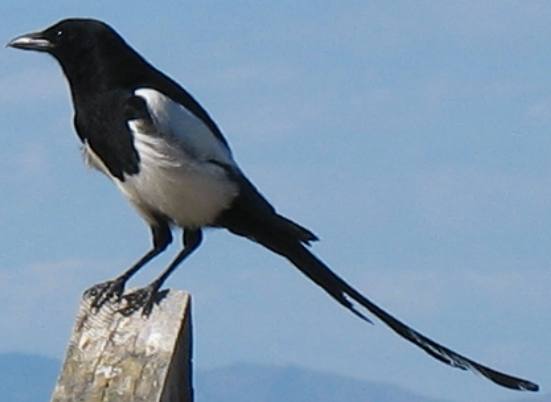

We weren't expecting to see a magpie at this
altitude but this one posed for us. We don't usually see magpie until we get to
much higher elevations. I think I recall the Great Salt Lake being around 4,000
feet in elevation.
By 1890, the teeming buffalo herds that
once roamed the Great Plains of America had been reduced to less than one thousand
animals. William Glassman, an Ogden, Utah, resident visiting friends in Texas,
became enthralled by the sight of a small bison herd. Recognizing the need to
preserve these fascinating animals, Glassman purchased a number of bison for a
planned zoological garden on the south shore of Great Salt Lake. He sold four
bulls, four cows and four calves to the owners of Antelope
Island. In early 1893 they were barged to the island, and turned loose.
They became the foundation of the present-day Antelope Island bison herd.
As
a result of William Glassman and the owners of the ranch on Antelope
Island, Antelope Island
is a refuge for one of the oldest and largest public herds of bison in the United
States. Those bison introduced in 1893 now numbers over 700 animals. Each fall,
the bison are rounded up and some are sold to limit the size of the herd with
the carrying capacity of the Island.
Large herds of bison are primarily
comprised of cows, calves and young nonbreeding bulls. Older bulls stay to themselves
most of the year in "bachelor" groups. Typically, only during breeding
season (July-August) do older bulls join the big herds. A 9-month gestation period
leads to calving season in late spring.
On Antelope
Island most bison give birth to their calves high up on the east slope
of the island. At higher elevations, there are more nutritious native grasses,
more water and it is cooler. They may also travel to these high elevations to
get away from people. The east slope is closed to people, to preserve it forever
as a refuge for bison and other wildlife.
The signature scene, the dangerous
buffalo hunt, from the movie "The Covered Wagon", was filmed on Antelope
Island. Released in 1923, it was one of the most successful films of the
silent era and the first epic western ever produced.
At the time the buffalo
herd numbered close to 200 buffalo. Cowboys from the Island Ranch hired on to
stampede the buffalo in front of the cameras. Even then it took three day before
the buffalo would cooperate.
The film was wildly received by the public
playing to capacity audiences for months. When the film opened with much excitement
at the Paramount Theater in Salt Lake City, the theater served buffalo burgers
at the front door. Now, only the location's name -- Camera Flat -- is left from
when Hollywood came to Antelope Island.
Later,
the "Last Great Buffalo Hunt" of 1926 that included heavyweight boxing
champ Jack Dempsey eliminated nearly all of the herd that had grown to over 400
head. Fortunately, enough survived that the herd was able to perpetuate itself.
I find it remarkable that as late as 1926 even national heroes were actively trying
to eliminate this species.
The island's forty springs afford buffalo and
other wildlife plenty of fresh water.
After the entire island was purchased
for a state park in 1981, management of the island's bison herd became the responsibility
of the state. A concerted effort was begun to improve the rangeland used by the
herd. In 1987, the Division of Parks and Recreation initiated a bison management
program. Each year, the otherwise free-roaming bison are rounded up, weighed,
vaccinated against disease, and checked for pregnancy. Outside animals have been
introduced to the herd to provide genetic diversity.
If you are interested,
Antelope Island's bison roundup
occurs in late October, and can be viewed by visitors. Bison corrals are located
on the north end of the island near near park headquarters.
We did not see
any of the Islands buffalo in our short visit but we did see pronghorn antelope
near the visitor center. The buffalo must have been further south than we were
able to get.
Does it get any better?
Until next
time remember how good life is.
Mike
& Joyce Hendrix
Until next time remember how good life
is.

Mike
& Joyce Hendrix who we are
We
hope you liked this page. If you do you might be interested in some of our other
Travel Adventures:
Mike & Joyce Hendrix's
home page
Travel
Adventures by Year ** Travel
Adventures by State ** Plants **
Marine-Boats ** Geology
** Exciting Drives ** Cute
Signs ** RV
Subjects ** Miscellaneous
Subjects
We
would love to hear from you......just put "info" in the place of "FAKE"
in this address: FAKE@travellogs.us
Until next time remember how good life
is.